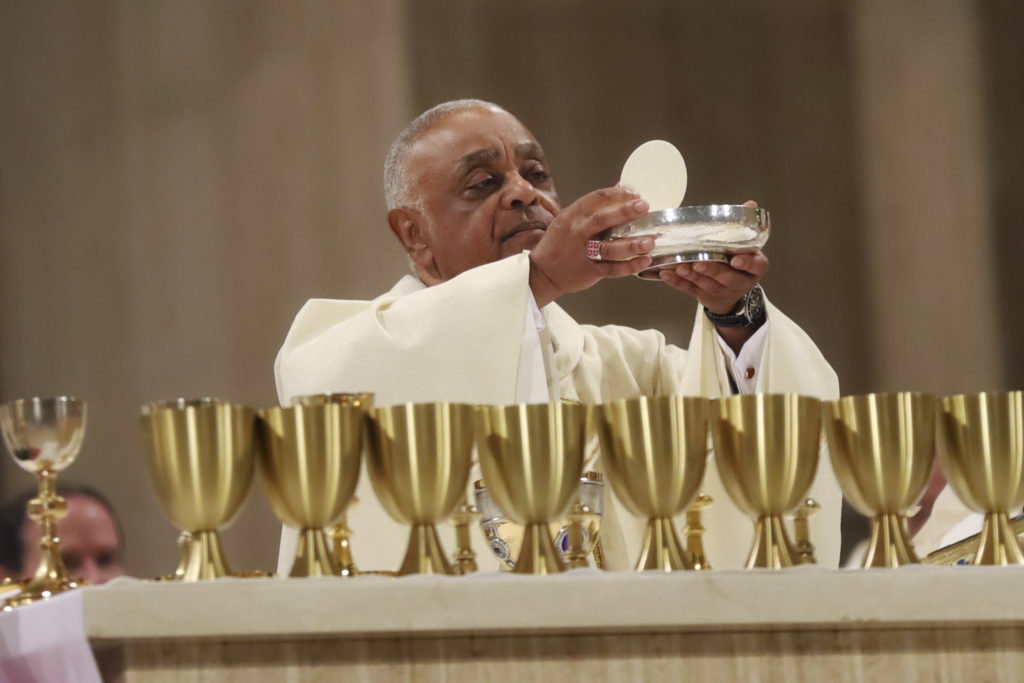
Why do restrictions on religious attendance cause “irreparable harm”?
A Catholic reflection on Diocese of Brooklyn v. Cuomo
Edward A. David
Photo by Sixteen Miles Out on Unsplash.
This article is part of our “Law and Religion Under Pressure: A One-Year Pandemic Retrospective” series.
If you’d like to check out other articles in this series, click here.
In Diocese of Brooklyn v. Cuomo (2020), the U.S. Supreme Court held that New York’s religious-attendance restrictions “would lead to irreparable injury” to religious communities and, if enjoined or rejected, “would not harm the public interest.” While the decision largely focused on the state’s unequal treatment of religion, the Court’s brief remarks concerning harm and the public interest merit further attention, particularly from the religious traditions those remarks represent.
In what follows, I offer a Roman Catholic perspective upon those aspects of the Court’s decision. (I leave an Orthodox Jewish perspective – especially from Agudath Israel of America, associated plaintiffs – to relevant experts.) My discussion focuses upon three areas: first, the relation of church and state during a public-health crisis; second, the importance of public worship, the interruption of which may cause “irreparable injury” for believers; and, third, our public or societal interest in fostering virtue through worship and, even, state law.
By no means exhaustive in scope, my discussion aims to help substantiate the moral and theological claims the Court has (implicitly) touched upon. It also offers points of reflection, particularly for Roman Catholic communities, as the nation navigates a second year of the pandemic.
1. The church and state have different roles
Diocese of Brooklyn and cases like it invite renewed reflection upon the proper roles of church and state, both in general and during a public-health crisis. Central to this query are the responsibilities that each association has toward individuals. By understanding these, we can begin to appreciate, or contextualize, the Court’s comments regarding harms and public interest.

We begin, then, with the moral and political philosophy of Saint Thomas Aquinas. As a general matter, Aquinas understands each association (inclusive of its responsibilities) according to its distinct purpose or end. Whereas the state’s end is the public good (involving the legal coercion of citizens’ external acts: see Summa theologiae I-II, 98, 1), the church’s end is heavenly fulfillment (involving the transmission of eternal life and the person’s free response in faith: see Summa contra gentiles III, 80, 15).
In a well-ordered political life, individuals belong to both types of association and so are subject to the jurisdiction of each. Summarily put: the state coerces externally, while the church encourages internally (that is, within the person herself). This dual citizenship, which reflects the domains of natural and theological reasoning, undoubtedly sparks tension between both spheres. Yet both associations are necessary for the imperfect beatitude, or fulfillment, of political life (in which individuals live in a reasonable and morally excellent way) as well as for the perfect beatitude promised by divine revelation (see John Finnis, sect. 1.2).
As Joseph Ratiznger, or Pope Emeritus Benedict XVI, puts it: “Each of these communities has a limited radius of activity, and keeping their mutual relationship in balance is the basis for freedom” (Ratzinger, ch. 8). What freedom? Both the political form, associated with the state’s limited end, and the supernatural, tied to the promise of Christ and the church.
Without reasonable state involvement, the former freedom could be jeopardized in various ways; and without the church’s transmission of divine life, the latter freedom would be unattainable. It is with these ends and freedoms in mind that we understand the proper roles of church and state, both in general and with respect to specific circumstances.
2. In-person worship saves
Natural freedom – that is, the type of liberty negotiated in law and politics – features prominently in Catholic social thought (see Catechism of the Catholic Church, par. 1730 onwards), and it is frequently appealed to by the Court (for example, see Justice Gorsuch on the legal freedom of worship in Southbay v. Newsom [2021]).
This is well and good. But a temptation exists, particularly in the church’s public discourse, to focus upon natural and legal freedoms instead or at the expense of the supernatural freedom offered by Christ. In other words, Catholics find themselves asserting individual freedoms exclusively in the language of secular liberal egalitarianism and thus stop short of thinking about, and giving voice to, the supernatural realities that those freedoms are meant to protect.
Leaving critiques of liberal egalitarianism to others (see Joel Harrison, chs. 2–4, for instance), I here focus upon the supernatural significance of public worship or what Catholics refer to as the mass. As the Brooklyn Court notes, “Catholics who watch a Mass at home cannot receive communion[.]” But why is this significant? Beyond mentioning a curtailment of First Amendment freedoms, the Court does not elaborate upon the “irreparable injury” experienced by Catholics. To fill this hole, I offer two brief theological reflections.
First, aside from being one means of exercising natural freedom, public worship for Roman Catholics entails (in its central form) a supernatural reality of the deepest eschatological significance: the celebration of the Eucharist. More than a metaphor or symbol of Christ’s body, the church teaches that the Eucharist actually is the body of Christ, the corpus verum or true physical body, which was sacrificed once and for all on the cross (Catechism, par. 1365) and was “poured out for many for the forgiveness of sins” (Mt 16:28).
Moreover, following Jesus’s words in the Gospel of John, Catholics believe that the in-person, physical consumption of this body is required for salvation and that, by eating Christ’s body, the faithful will be physically resurrected at the end of time: “Truly, truly, I say to you, . . . he who eats my flesh and drinks my blood has eternal life, and I will raise him up at the last day” (Jn 6:53–54).
The radical offer of eternal life, promised through a literal consumption of the corpus verum, constitutes in part the scandal of Catholic worship (see Jn 6:60–66). No less astonishing is the belief that reception of the Eucharist incorporates believers into the church, “which is the Body of Christ” (Catechism, par. 1368), understood not in a merely metaphorical sense but as a mysterious body (see discussions in Henri de Lubac, ch. 2 or Winnifred Fallers Sullivan, ch. 1).
Indeed, the church is the corpus mysticum, or mystical body, to which the faithful are supernaturally joined through the public celebration of the Eucharist. When physically cut off from this corporate mystery, Catholics are denied full participation in a social reality which transcends, and sanctifies, the life of believers. Given the significance, “irreparable injury” is an apt term.
3. Account for harm, but move toward virtue
Following discussion of irreparable harms, the final section of the Court’s Brooklyn decision touches upon “public interest,” here defined with reference to the spread of COVID-19: “The State has not claimed that attendance at the applicants’ services has resulted in the spread of the disease. And the State has not shown that public health would be imperiled if less restrictive measures were imposed.”
Certainly, the harm argument is important to make. But rather than dwell on the Court’s balancing of interests, I wish to draw our attention to one of the argument’s underlying assumptions: the idea that the state has an important role to play in our moral reasoning and life together. This much has already been stated (see Section 1 above); yet more can and must be said, particularly with regard to the development of virtue. Once more, we return to Aquinas.
Aquinas, we recall, posits different ends for the church and state: the latter is concerned with the public good (or, alternatively, the temporal common good); the former aims toward perfect beatitude. In maintaining this distinction, Aquinas effectively departs from the classic Aristotelian position which holds that the state is the only perfect community and, correspondingly, has a duty toward the perfect virtue of its citizens. On Aquinas’s account, by contrast, it is the church – the other complete community to which individuals (can freely) belong – that has charge over the full development of its members’ virtue and right moral reasoning (see Finnis, sect. 6).
Again, the reason for this has to do with each group’s distinct ends. Concerned with the temporal common good, the state limits itself and its legal coercion to the external exercise of justice – that is, to the external actions of choosing and acting persons. By contrast, the church acts on divine authority and thereby seeks to bring its members to perfect fulfillment through the cultivation of virtue at the deepest personal level and in accord with natural and divine law (see Summa theologiae I-II, 100, 2, especially on the limits of human law with respect to virtue).

Now, if perfect virtue is only acquired through the church (and especially through participation in its public worship: see Catechism, par. 1391 onward, concerning the fruits of the Eucharist), then one can see how the state – through laws and other suasive actions – can facilitate or hinder the church’s moral pedagogy. The state, therefore, plays some role in the deeper, more personal development of citizens’ moral character.
Of course, the state’s pedagogy often goes beyond an externally focused, justice-based moral position. Diocese of Brooklyn is a case in point. When the state subjects religious institutions but not other associations to particularly strict COVID measures, it sends a preferential message that denigrates the importance of religion in society. (And, arguably, Governor Cuomo’s apathetic response to the Court’s decision reinforced a negative sentiment.)
The state is thus a moral teacher both in practice and in principle, whether the church likes it or not. Against its unreasonable moral claims, the church must double down so as to cultivate full virtue among members, thus fulfilling its proper and supernatural end. What the church might commit to in this regard (apart from prudent legal action) depends, as most things do, upon the circumstances.
Nevertheless, following the above reflections, three general suggestions – succinctly put – may be helpful: Own the church’s distinct role. Preach the fullness of faith. And put virtue into practice, through safe in-person worship and creative solutions that serve society’s post-pandemic needs. In doing so, the church can heal “irreparable harms” while serving the public interest more fully. ♦

Edward A. David is a postdoctoral research fellow in the Faculty of Theology and Religion at the University of Oxford. In addition to his work in the field of law and religion, Edward researches values-based leadership with The Oxford Character Project and is a lead author of the Goldman Sachs 10,000 Women and 10,000 Small Businesses UK programs. Edward can be found on Twitter @edwardinoxford and at edwardadavid.com.
Recommended Citation
David, Edward A. “Why do restrictions on religious attendance cause ‘irreparable harm’? A Catholic reflection on Diocese of Brooklyn v. Cuomo.” Canopy Forum, April 20, 2021. https://canopyforum.org/2021/04/20/why-do-restrictions-on-religious-attendance-cause-irreparable-harm-a-catholic-reflection-on-diocese-of-brooklyn-v-cuomo/


